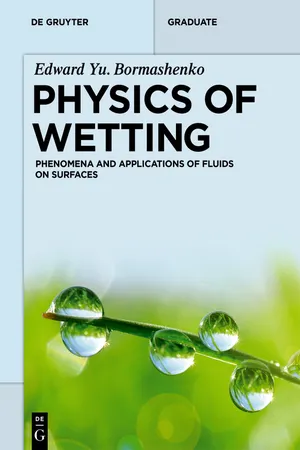
Physics of Wetting
Edward Yu. Bormashenko
- 254 pages
- English
- ePUB (mobile friendly)
- Available on iOS & Android
Physics of Wetting
Edward Yu. Bormashenko
About This Book
Motivated by a plethora of phenomena from nature, this textbook introduces into the physics of wetting of surfaces. After a brief discussion of the foundations of surface tension, its implementation for floating objects, capillary waves, bouncing droplets, walking of water striders, etc. is discussed. Furthermore, Marangoni flows, surface tension inspired instabilities, condensation and evaporation of droplets, liquid marbles, superhydrophobicity and superoleophobicity (lotus effect) are introduced. All relevant concepts are illustrated by the numerous qualitative and quantitative exercises.
Contents
What is surface tension?
Wetting of surfaces: the contact angle
Surface tension-assisted floating of heavy and light objects and walking of water striders
Capillary interactions between particles. Particles placed on liquid surfaces. Elasticity of liquid surfaces, covered by colloidal particles
Capillary waves
Oscillation of droplets
Marangoni flow and surface instabilities
Evaporation of droplets. The Kelvin and the coffee-stain effects
Condensation, growth and coalescence of droplets and the breath-figure self-assembly
Dynamics of wetting: bouncing, spreading and rolling of droplets (water hammer effect – water entry and drag-out problems)Superhydrophobicity and superoleophobicity: the Wenzel and Cassie wetting regimes
The Leidenfrost effect. Liquid marbles: self-propulsion
Physics, geometry, life and death of soap films and bubbles
Frequently asked questions
Information
1What is surface tension?
1.1Surface tension and its definition


Table of contents
- Cover
- Title Page
- Copyright
- Dedication
- Preface
- Contents
- Symbol index
- 1 What is surface tension?
- 2 Wetting of surfaces: the contact angle
- 3 Surface tension-assisted floating of heavy and light objects and walking of water striders
- 4 Capillary interactions between particles. Particles placed on liquid surfaces. Elasticity of liquid surfaces, covered by colloidal particles
- 5 Capillary waves
- 6 Oscillation of droplets
- 7 Marangoni flow and surface instabilities
- 8 Evaporation of droplets. The Kelvin and the coffee-stain effects
- 9 Condensation, growth and coalescence of droplets and the breath-figure self-assembly
- 10 Dynamics of wetting: bouncing, spreading and rolling of droplets (water hammer effect – water entry and drag-out problems)
- 11 Superhydrophobicity and superoleophobicity: the Wenzel and Cassie wetting regimes
- 12 The Leidenfrost effect. Liquid marbles: self-propulsion
- 13 Physics, geometry, life and death of soap films and bubbles
- Index